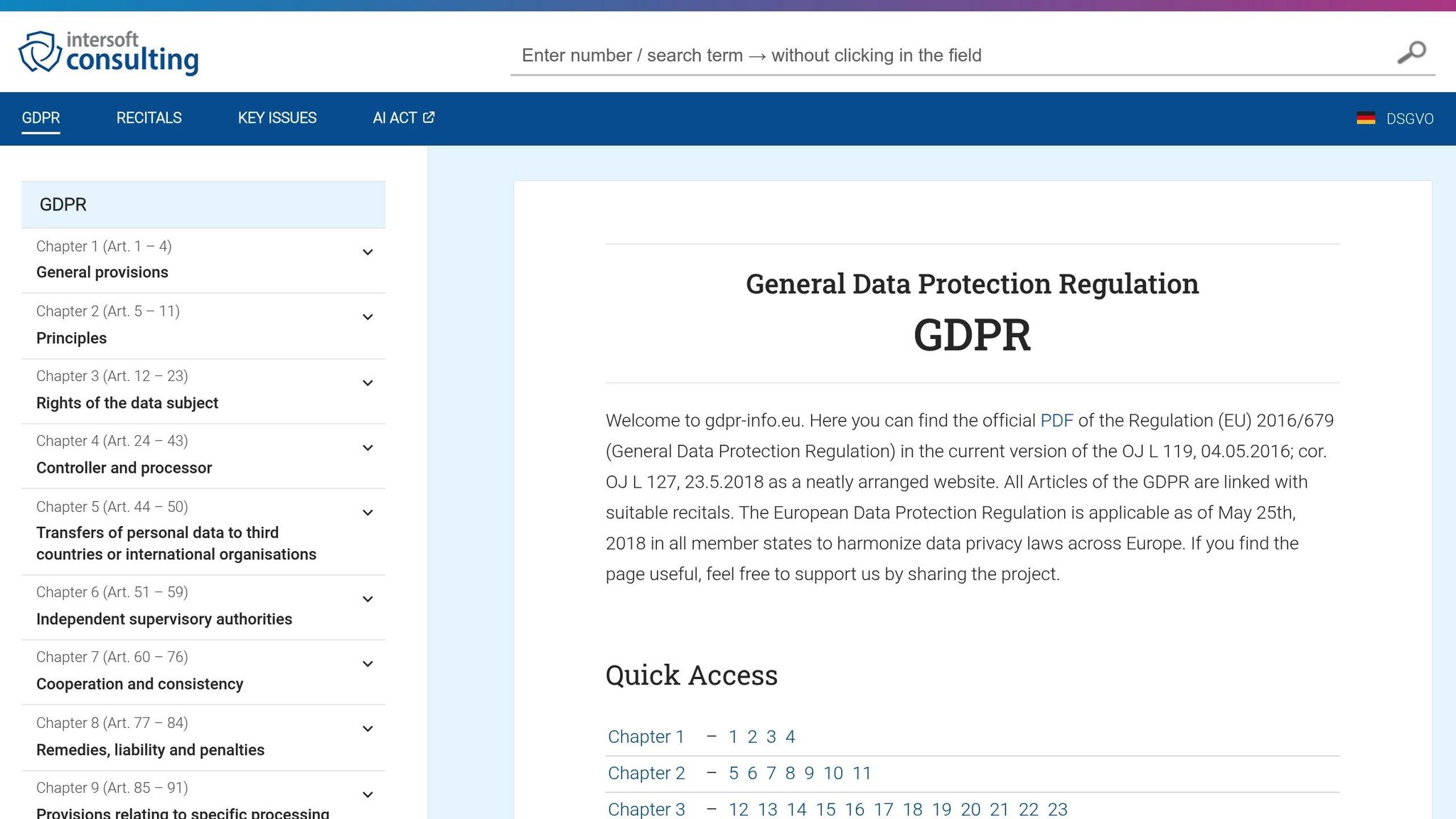Cross-border data transfers in blockchain are tricky because they involve decentralized systems clashing with international privacy laws like GDPR, CCPA, and data localization rules in China and Russia. Here’s what you need to know:
- GDPR Compliance: Use off-chain storage, cryptographic deletion, or smart contracts to handle "right to be forgotten" requests.
- CCPA Guidelines: Focus on consent management and off-chain storage for California residents’ data.
- Localization Laws: Countries like China and Russia require data to stay within their borders, posing challenges for blockchain’s global nature.
- Technical Tools: Zero-knowledge proofs (ZKPs) and smart contracts help balance privacy and compliance.
- Legal Frameworks: Standard Contractual Clauses (SCCs) and Binding Corporate Rules (BCRs) can simplify international data transfers.
To stay compliant, blockchain networks must combine legal strategies with technical solutions, like hybrid storage setups and automated compliance via smart contracts.
PICCASO Podcast S2 E1 – Privacy for Blockchain with Ash …

Cross-Border Data Transfer Issues
Blockchain networks face both technical and legal obstacles when handling data transfers across international borders. Because these networks are decentralized, transactions often involve nodes located in multiple regions. For instance, a single transaction might fall under the European Union’s GDPR and the United States’ CCPA at the same time, creating jurisdictional conflicts that need careful examination.
The design of blockchain itself adds another layer of complexity. Since blockchain data is immutable – meaning it can only be added to and not altered – complying with privacy laws that require data modification or deletion becomes a significant challenge.
Addressing these problems requires a mix of legal and technical solutions that ensure compliance with global data protection rules without undermining the decentralized nature of blockchain.
Current Data Transfer Laws
Blockchain networks operate under a patchwork of legal requirements worldwide. For instance, GDPR Article 44 mandates that any transfer of personal data outside the European Economic Area (EEA) must meet strict compliance standards. This means blockchain networks dealing with data from EU citizens need to implement rigorous technical and organizational measures to align with GDPR rules.
In the U.S., the California Consumer Privacy Act (CCPA) – in effect since January 1, 2020 – requires clear and transparent data practices. Blockchain networks must document their data-processing activities and ensure California residents can exercise their privacy rights, even for international data transfers.
These regulations illustrate how legal frameworks influence how blockchain networks manage cross-border data transfers.
1. GDPR Requirements

The "right to be forgotten" under GDPR poses challenges for blockchain’s unchangeable nature. However, there are ways to address this issue:
-
Off-Chain Storage
Instead of storing personal data directly on the blockchain, keep it off-chain and link it using a reference like a hash. This way, the data itself can be deleted without altering the blockchain’s integrity. -
Cryptographic Deletion
Even if data remains recorded, destroying the associated decryption keys makes it unreadable. This approach satisfies GDPR’s data erasure requirements. -
Smart Contract Controls
Use smart contracts to regulate access to personal data. These contracts can be designed to revoke access when deletion requests are approved, ensuring compliance.
These approaches demonstrate how technology can address GDPR requirements while maintaining blockchain’s core principles.
2. CCPA Guidelines
The CCPA gives California residents control over their personal data, including rights to access, delete, opt out of data sales, and understand how their information is used. However, these rights clash with blockchain’s core feature: an unchangeable, decentralized ledger.
This conflict has pushed legal experts to explore global solutions for compliance. Many blockchain networks now depend on off-chain storage to meet the CCPA’s transparency rules. Additionally, smart contracts are being updated to include consent management, ensuring compliance while maintaining the decentralized nature of blockchain.
For blockchain networks handling California residents’ data, integrating privacy-focused design and aligning with evolving legal standards is crucial.
3. China and Russia Data Laws
Unlike GDPR and CCPA, which focus on privacy rights, some countries enforce strict data localization rules. China and Russia require certain data to be stored within their borders, creating obstacles for blockchain’s decentralized storage model.
In China, the Cybersecurity Law mandates that personal data be stored on servers located within the country. This means blockchain networks handling data from Chinese citizens must adapt their storage methods to comply with these rules.
Russia’s Federal Law on Personal Data has a similar requirement. It obligates companies processing Russian citizens’ personal data to store it on servers within Russia. This poses a challenge for blockchain systems, which typically distribute data across global nodes.
Failing to comply with these regulations can lead to operational disruptions and financial penalties. Blockchain projects must carefully design their data flows and network setups to align with these legal demands.
Bestla VC works on strategies that balance local data storage laws with the decentralized nature of blockchain systems.
sbb-itb-c5fef17
4. SCCs and BCRs
Legal tools like SCCs (Standard Contractual Clauses) and BCRs (Binding Corporate Rules) play a critical role in managing cross-border data transfers, especially when blockchain networks interact with international data protection laws.
What Are SCCs?
SCCs are pre-approved contractual clauses designed to ensure compliance with GDPR when transferring data outside the European Economic Area (EEA). These clauses require data importers to meet GDPR standards, offering a structured way to manage international data transfers. For blockchain networks, SCCs are especially important for handling cross-jurisdictional data flows.
To implement SCCs effectively, blockchain networks must:
- Clearly document how data flows across borders.
- Use strong technical safeguards to protect data.
- Establish mechanisms for addressing data subject rights.
- Have clear procedures for notifying breaches.
What About BCRs?
BCRs are internal policies used by corporate groups to manage data transfers within their organization. While not commonly used in traditional blockchain setups, they can be useful in consortium blockchains where multiple companies collaborate.
Choosing Between SCCs and BCRs
The decision to use SCCs or BCRs depends on the structure of the blockchain network and the entities involved. For example, SCCs might be more practical for decentralized networks, while BCRs could work better for consortium blockchains. Legal advice is often necessary to create a compliant framework.
Practical Steps for Implementation
To meet regulatory requirements, blockchain networks should:
- Regularly audit data flows to ensure compliance.
- Maintain detailed records of all cross-border transfers.
- Enforce technical safeguards to protect data.
- Set up clear processes for handling data subject requests.
Smart contracts and well-designed technical systems can help maintain compliance without sacrificing operational efficiency.
5. Zero-Knowledge Proof Systems
As blockchain technology navigates varying global regulations, zero-knowledge proofs (ZKPs) are emerging as a solution to address compliance challenges. These systems allow for data verification without revealing the underlying information.
How ZKPs Work in Practice
ZKPs enable blockchain networks to validate transactions and data while maintaining privacy. For example, they can confirm compliance with regulatory requirements without sharing the complete dataset.
Advantages for Cross-Border Compliance
ZKP systems bring several benefits when handling international data transfers:
- Privacy Protection: Verifies data without exposing sensitive details, reducing compliance risks.
- Selective Data Sharing: Allows organizations to prove specific attributes without disclosing entire datasets.
- Reduced Data Movement: Only the proof of validation is shared, avoiding the transfer of sensitive data.
Despite these benefits, implementing ZKPs involves overcoming some technical challenges.
Implementation Challenges
Deploying ZKPs comes with notable technical obstacles:
| Challenge | Impact | Consideration |
|---|---|---|
| Computational Complexity | Requires significant processing power | May slow down transaction speeds |
| Scalability Issues | Limits throughput capacity | Could hinder large-scale use |
| Standardization Gaps | Lack of uniform implementation | Makes compliance checks more difficult |
Technical Requirements
To successfully adopt ZKP systems for cross-border data transfers, blockchain networks must meet these technical needs:
- Advanced Cryptographic Tools: Secure encryption methods for creating and verifying proofs.
- High-Performance Processing: Hardware capable of handling complex ZKP calculations efficiently.
- Uniform Protocols: Clear standards for proof generation and validation across jurisdictions.
Integration with Current Systems
For ZKPs to work effectively, they must integrate smoothly with existing blockchain frameworks while adhering to regulatory requirements. This involves setting up clear processes for creating, verifying, and storing proofs. Proper integration strengthens compliance efforts across international blockchain networks.
6. External Data Storage Methods
External data storage solutions play a key role in managing cross-border compliance for blockchain networks, especially when dealing with international data transfers.
Hybrid Storage Architecture
Many blockchain systems now use a mix of on-chain and off-chain storage. This approach ensures sensitive personal data is stored externally, while the blockchain maintains transaction accuracy.
| Storage Component | Data Type | Compliance Advantage |
|---|---|---|
| On-chain | Hash references, timestamps | Limits exposure of personal data |
| Off-chain | Personal details, documents | Allows direct control over data location |
| Verification Links | Proofs of verification | Ensures data integrity without revealing personal details |
This hybrid setup fits well into broader compliance strategies for blockchain networks.
Distributed Storage Solutions
Distributed storage systems must balance blockchain’s decentralized principles with data protection rules. Here are some approaches:
- Distributed File Systems: Use encrypted data chunks with geographic restrictions, access controls, and audit trails to align with regulations.
- Private Storage Networks: Store sensitive data within approved regions, enforce detailed access controls, and comply with local laws.
- Smart Contract Integration: Manage data access, track cross-border transfers, and enforce region-specific rules automatically.
Securing these systems is critical, as explained below.
Security Considerations
When setting up external storage, organizations should focus on these key security measures:
- Encryption: Use encryption protocols tailored to specific regions.
- Access Controls: Set role-based permissions to limit data access.
- Audit Mechanisms: Keep logs of all cross-border data movements.
- Recovery Protocols: Ensure data remains accessible in case of disruptions.
Performance Optimization
To keep blockchain systems running smoothly while using external storage, consider these tips:
- Cache frequently accessed data locally.
- Use efficient data retrieval methods.
- Distribute storage evenly.
- Monitor and minimize transfer delays.
Compliance Documentation
Thorough documentation is essential to prove adherence to global data regulations. Organizations should maintain detailed records of their external storage practices, such as:
- Data location and mapping
- Transfer processes
- Security measures
- Access control policies
These records are invaluable for audits and help ensure ongoing compliance with international laws.
7. Compliance Through Smart Contracts
Smart contracts now provide automated solutions for regulatory compliance, particularly in blockchain systems. With blockchain’s unchangeable nature, these contracts enforce data protection rules and log transactions securely.
How Smart Contracts Enable Compliance
Smart contracts use built-in mechanisms to streamline compliance:
| Feature | Function | Compliance Advantage |
|---|---|---|
| Geographic Restrictions | Validates data transfer locations | Ensures transfers occur only between approved jurisdictions |
| Consent Management | Tracks user permissions | Helps meet GDPR requirements for user data rights |
| Audit Logging | Records all data movements | Provides unalterable compliance documentation |
| Access Controls | Enforces role-based permissions | Limits data access to authorized individuals |
Adapting to Changing Rules
Smart contracts are designed to:
- Quickly update regulatory parameters
- Apply jurisdiction-specific rules automatically
- Stay aligned with evolving regulations
- Roll out updates across the network seamlessly
Enhancing Privacy with Zero-Knowledge Proofs
Modern smart contracts use zero-knowledge proof systems to safeguard privacy while ensuring compliance. These systems verify:
- Legitimacy of data transfers
- Adherence to regulations
- Geographic restrictions
- User consent
This ensures compliance without exposing sensitive information.
Real-World Compliance Automation
Here are two practical ways smart contracts automate compliance:
- Data Transfer Verification: Smart contracts automatically validate transfer requests against regulatory requirements. Only transfers between compliant jurisdictions are approved.
- Audit Trail Creation: They generate detailed audit logs, including timestamps, jurisdiction checks, compliance validations, and authorization data.
Key Steps for Implementation
To effectively use compliance-focused smart contracts, organizations should:
- Develop modular contract structures to simplify updates
- Include fallback options for regulatory changes
- Conduct thorough testing
- Keep detailed documentation of compliance processes
Simplified Monitoring and Reporting
Smart contracts can automatically produce compliance reports, tracking:
- Data transfer volumes by jurisdiction
- Attempts to violate compliance rules
- Consent management statistics
- Implementation of regulatory updates
This automation reduces the need for manual oversight, improving both efficiency and accuracy in managing compliance.
Compliance Methods and New Developments
The landscape of compliance continues to evolve, with smart contracts and zero-knowledge proofs shaping new methods and strategic frameworks in the industry.
Advanced Compliance Technologies
Technologies like zero-knowledge proofs and smart contracts are transforming how data privacy is safeguarded while ensuring adherence to regulatory standards.
Enterprise-Level Solutions
Enterprises are now implementing integrated frameworks that merge privacy-focused techniques with automated monitoring. These solutions simplify compliance with various legal requirements while ensuring strong data protection during transfers.
Institutional Integration
Organizations are adopting privacy-first architectures and proactive risk management approaches to meet changing regulatory expectations. This shift is fueling ongoing advancements in compliance tools and strategies.
Strategic Legal Structures
Legal professionals are creating international frameworks tailored for web3 and crypto operations. These frameworks tackle challenges like cross-border activities and data sovereignty by offering flexible solutions that align with diverse legal systems.
Future-Ready Compliance
The future of compliance will depend on real-time monitoring and automated updates. These features will make managing cross-border data transfers more efficient and responsive.
Conclusion
As blockchain transactions cross international borders, robust protocols are crucial to meet regulatory requirements in an ever-expanding landscape. Addressing these hurdles through legal strategies and technical advancements lays the groundwork for the combined approach outlined here.
Organizations need to bring together expert legal advice and cutting-edge technical solutions to stay compliant. By doing so, they can effectively navigate shifting regulatory environments while maintaining operational efficiency.
With blockchain technology evolving rapidly, combining legal expertise with technical solutions becomes increasingly important. At Bestla VC, we blend legal knowledge with technical tools to safeguard user privacy and comply with global regulations.
Related posts
- Zero-Knowledge Proofs: Applications in DeFi
- Bybit’s $1.5B Hack: OTC Market Opportunities and Security Solutions for Crypto Exchanges in 2025
- 2025 Web3 Legal Essentials: Structuring Your Crypto Project for Compliance and Success
- Trump’s Crypto Reserve Boosts Bitcoin and Ethereum: How OTC Services Ensure Security in the New Financial Landscape


